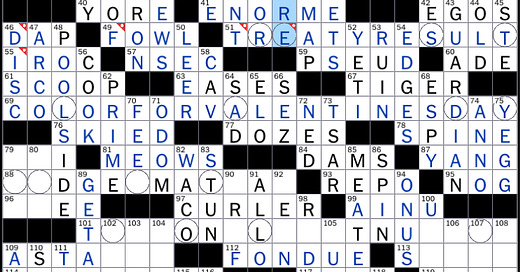In my last post, I described finding Dungeons & Dragons used as a clue in a New York Times crossword puzzle from 2012. I also admitted that, much to my embarrassment, I could not for the life of me figure out a 4-letter word for "Dungeons & Dragons figure.” Well, I kept at it. I cheated a little by consulting the key to make sure I was correctly filling in the words near it and intersecting with it. And I worked it out. The answer is “ogre.” As simple as that.
Yes, I feel more than a little stupid for not having worked it out earlier. That is, I think, in keeping with the intentions of any self-respecting crossword puzzle designer. But I think it also proves my point that this is a sign of how D&D has worked itself into the larger culture. Ogres are one of the most generic creatures in the Monster Manual — a familiar part of the standard repertoire, as it were. Their origins are rooted in the culture at large, just as much as those of dragons, elves and goblins. According to Wikipedia, the name goes all the way back to Chretien de Troyes’ Perceval, so it’s almost a thousand years old by now, at least. Furthermore, monsters that fit the general concept have existed since the dawn of civilization, in mythologies the world over.
In other words, once designer Daniel A. Finan decided that he wanted “ogre” in the 34-Down slot, he had a staggering array of options for the clue, one that stretched back millennia and across virtually all of the world’s major cultures. So why did he need to go to D&D as his reference point? Perhaps an ogre had just flattened his 2nd-level half-elf fighter with a mighty blow from its greatclub in his regular game? Whether or not that’s true, he must have assumed that enough people knew enough about D&D so that the clue would prove a worthy, but ultimately fair test of wits and cultural literacy for the average New York Times reader. If he had wanted to use a truly obscure and nerdy clue for “ogre,” he could have gone with, “Steve Jackson MicroGame #1.” It was a test on which I scored no better than a C, I think. But at this point in my life it’s not the first test from which I walked away with my tail between my legs, so, whatever.
In my defense, I will say that this puzzle is one of those particularly sadistic ones in which the core answers — the long ones that form the spine of the puzzle — have only the most obscure and roundabout connection to the clue that you can imagine, and they key to connecting the answer to the clue is to spell out a word formed by the letters that go into circled spaces in the former. But of course, it’s very hard to figure out that connecting word without working out most of the letters in the answer already. So it feels like trying to enter a roundabout where the traffic is moving too fast for you to safely get in. Normally, the process of solving a Sunday puzzle can work both ways — getting a bunch of smaller answers can help you solve the big ones, but a flash of insight that reveals one of the big answers can also lead you to solving the small ones that intersect with it. One way is just as good as the other. But these circle space puzzles basically shut off the latter route because you can’t get the full answer without the lynchpin word, and you can’t get the lynchpin word without filling in most if the letters to than answer by solving a lot of the short answers that intersect with it.
Unless you cheat by consulting the key. Which I did, a little. Followed by yelling, “But that’s not even a word!” at my phone.
[By the way, we’re down to the last full week on my Kickstarter campaign for Places by the Way #13: The Hobgoblin’s Fortress and Found by the Way #14: Path to the Hobgoblin's Fortress. We’re only 70% funded as of this writing, so we could use some help in the stretch run to get over the top. If you haven’t already, check out the campaign and please consider kicking in.]





Upped my pledge to include all the other modules I will add on later
I have to confess to feeling a little short-changed by the solution. After all, on this rather loose basis, one can justify the solution as being ‘bard’ or ‘nerd’ or ‘hero’ or almost any other term that could be, rather generically, associated with ‘fantasy’ and gaming culture. ‘Monster created from chaotic gore’ took me 30 seconds to come up with and - while very simple - has, I think, a more pleasingly cryptic structure.